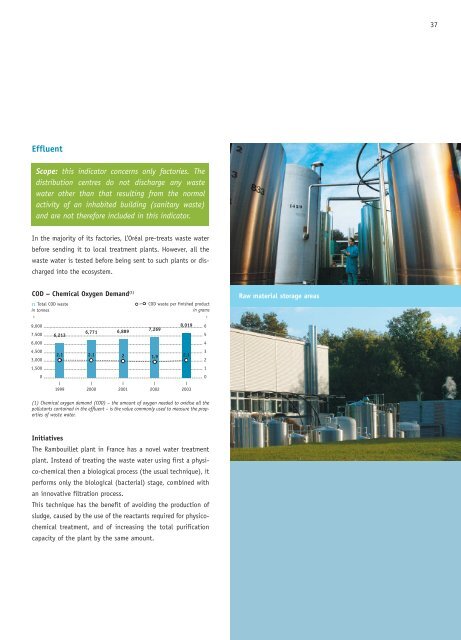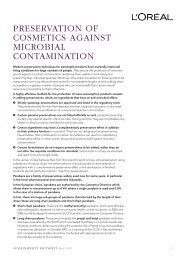Download 2003 Sustainable Development Report (PDF)
Download 2003 Sustainable Development Report (PDF)
Download 2003 Sustainable Development Report (PDF)
Create successful ePaper yourself
Turn your PDF publications into a flip-book with our unique Google optimized e-Paper software.
37<br />
Effluent<br />
Scope: this indicator concerns only factories. The<br />
distribution centres do not discharge any waste<br />
water other than that resulting from the normal<br />
activity of an inhabited building (sanitary waste)<br />
and are not therefore included in this indicator.<br />
In the majority of its factories, L’Oréal pre-treats waste water<br />
before sending it to local treatment plants. However, all the<br />
waste water is tested before being sent to such plants or discharged<br />
into the ecosystem.<br />
COD – Chemical Oxygen Demand (1)<br />
n Total COD waste<br />
in tonnes<br />
t<br />
9,000<br />
7,500<br />
6,000<br />
4,500<br />
3,000<br />
1,500<br />
0<br />
6,213<br />
I<br />
1999<br />
6,771<br />
I<br />
2000<br />
6,889<br />
I<br />
2001<br />
COD waste per finished product<br />
in grams<br />
7,269<br />
I<br />
2002<br />
8,019<br />
2.1 2.1<br />
2 1.9 2.1<br />
I<br />
<strong>2003</strong><br />
tx<br />
6<br />
5<br />
4<br />
3<br />
2<br />
1<br />
0<br />
Raw material storage areas<br />
(1) Chemical oxygen demand (COD) – the amount of oxygen needed to oxidise all the<br />
pollutants contained in the effluent – is the value commonly used to measure the properties<br />
of waste water.<br />
Initiatives<br />
The Rambouillet plant in France has a novel water treatment<br />
plant. Instead of treating the waste water using first a physico-chemical<br />
then a biological process (the usual technique), it<br />
performs only the biological (bacterial) stage, combined with<br />
an innovative filtration process.<br />
This technique has the benefit of avoiding the production of<br />
sludge, caused by the use of the reactants required for physicochemical<br />
treatment, and of increasing the total purification<br />
capacity of the plant by the same amount.



